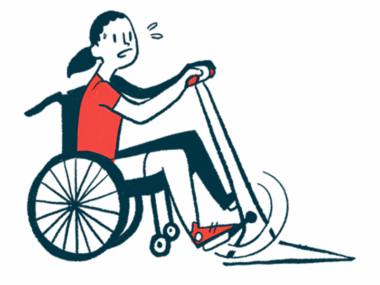How foot symptoms of MS affect my balance, quality of life
Curiously, I can't tolerate wearing socks
Written by |

Most people take for granted the feeling of stability while standing on their feet. My invisible multiple sclerosis (MS) symptom is unsteady gait, one of my biggest struggles, but you likely wouldn’t know it just by looking at me. My unsteady gait is associated with the effect that MS has on my feet.
I do well walking on a flat surface, except occasionally bumping into things or people. Walking in a straight line is difficult, though, as I tend to slightly weave from side to side.
If the surface is uneven, I don’t feel stable. It affects my balance, and my gait becomes unsteady. I feel even less stable when I’m walking in the dark. A common fear of mine is that I’ll fall in these situations.
Where’s my toe?
When I was diagnosed with MS, my physician referred me to a physical therapist, who performed an evaluation where I closed my eyes and she moved my big toes up and down. She asked me what direction my toes were being moved toward. To my shock, I didn’t know. I knew my toes were being touched and moved, but I had no idea in which direction.
This is called impaired proprioception. Proprioception is the body’s ability to sense or identify movement, action, and location. My feet can’t sense movement or direction, which causes some of my balance issues and unsteady gait.
I compensate for this deficiency with my eyesight. If I’m walking my dogs on the sidewalk during the day, I look pretty normal. If I walk in the grass and can’t see the uneven terrain or it’s dark out, my balance and gait become significantly worse, and you can tell something is wrong with me.
Another issue is that I can’t tolerate wearing socks. Before my diagnosis, I could wear socks without any problems.
Typically, you put on socks and don’t feel like you’re wearing them. When I wear them, I feel them constantly. Sometimes, they feel too tight when they fit just fine. Other times, it feels like the socks are too big and I’m walking on wrinkled material. This sensation is tough to explain, and I don’t know if there’s a scientific term for it. My solution is to avoid wearing socks if I can. I’m most comfortable at home and prefer to be barefoot.
Now let’s talk about shoe shopping. Surprisingly, I don’t get the same sensation from wearing shoes that I get from socks, which I find strange, but I’m not complaining. When I was younger, I bought and wore shoes that were fashionable, regardless of whether or not they were comfortable or gave me blisters. I always had trouble wearing high heels, but I blamed it on general clumsiness. In retrospect, misdiagnosed MS was to blame.
As I got a little older, comfort became more important, especially with the shoes I wore to work.
Since my diagnosis, not only is comfort important in footwear, but I also want to feel stable. Casual shoes and flats that meet these requirements are easy to find. The challenge is finding dressy shoes. Thank goodness block-heeled or chunky-heeled shoes came back in style a few years ago. I don’t feel 100% stable in this type of shoe, but I also know that my chance of falling is less than if I wore kitten-heeled, stiletto, platform, or wedge shoes. Shoe shopping has become more challenging since my MS diagnosis.
MS can cause other foot problems as well, including foot drop, weakness, muscle fatigue, numbness, pain, spasms, and spasticity. I have all of these issues except spasms and pain. I have mild left-sided weakness with a slight foot drop on that side, and numbness, fatigue, and spasticity in both feet.
The weakness and foot drop are residual effects from my first experience with MS in 1996. Since then, they haven’t worsened and have remained stable.
These symptoms are present when my MS clinician evaluates me, but I don’t feel like they negatively affect my mobility to a significant degree. I notice the numbness, fatigue, and spasticity more in the evenings, and sometimes they’re severe enough to cause insomnia. At bedtime, I take tizanidine, a skeletal muscle relaxant, to manage the spasticity.
Foot health and its effect on quality of life have rarely been studied in people with MS. Only one study that I know of has evaluated it and found that people with MS and foot health issues (such as foot function, general foot health, general health, physical activity, and vigor) have poorer quality of life compared with healthy individuals. As someone living with MS, I don’t find the results of this study surprising, nor do I take my foot heath and its impact on my life for granted.
Note: Multiple Sclerosis News Today is strictly a news and information website about the disease. It does not provide medical advice, diagnosis, or treatment. This content is not intended to be a substitute for professional medical advice, diagnosis, or treatment. Always seek the advice of your physician or other qualified health provider with any questions you may have regarding a medical condition. Never disregard professional medical advice or delay in seeking it because of something you have read on this website. The opinions expressed in this column are not those of Multiple Sclerosis News Today or its parent company, Bionews, and are intended to spark discussion about issues pertaining to multiple sclerosis.







Cynthia MacFarlane
Enjoyed your column. Thanks !
I have the same foot issues. I find the Noboso textured insoles very helpful . And for spasms ( so painful when they happen in the arch of your foot ... Ouch !) and spasticity , my rehab specialist recommended tonic water every day ( for the quinine) . It really seems to help!
Deborah Rombouts
Did he specify gin to go in said tonic? Sounds much more fun than Botox injected under the toes 😉
Mark B
I have similar issues with my feet. I find compression socks with toes cut out are a lot more comfortable than normal socks
SPIRIDON ARTINOS
Thank you very much for the article which really describes what we are going trough every day but would appreciate receiving
a feed back whether there is any suggestion how our balance could be improved apart from the usual exercises.
Kind regards
S.Artinos
A.L.
OMG, you get it! I feel the exact way about socks and what I can and cannot put on my feet. In my perfect world I would go barefooted always. If it’s cloudy outside or the wind is blowing I also feel unstable walking. It appears to me the ground is no longer level. As the shadows move around, my brain doesn’t seem to acknowledge it isn’t moving.
Klaire Dettenmaier
Can’t handle socks, even married barefoot. The only way I felt Steady on my feet.
Guillermo Mendoza
Coincidental or not I have foot drop on the same side I have plantar fasciitis. I presume it is related. Probably first indication that something was beginning to happen on that side. Also failed to notice foot drop associated outward swinging of foot until the day I happened to look down and was surprised to see rather obvious swinging. It is noticeable when fatigue from walking sets in.
Doris Parlette
I could have written this article! The only difference is that my diagnosis was in 1982. I now use a rollator to assist me on uneven pavement. Thanks to Prof. Nelson for letting me know I am not alone with these foot and balance issues!
Ellen
My foot problems occurred with my first major MS symptom called transfer myelitis. That diagnosis led me to the MS diagnosis. I recovered from transverse myelitis, except for leaving.both my feet Mostly my toes and the balls of my feet with sensory type of numbness. So sometimes I feel like I have socks on when I don’t have socks on. I don’t have the same problems you did with socks or shoes I walk OK without any canes or help, but I cannot because of MS walk toe to heel which is what my neurologist usually tests me on and I lose my balance when I try to do that. Other than that I have now had MS diagnosed since I was 57 and I’m now 76.
Charles Lumia
I have the same problem. I'm unstable in general but if I don't wear very flat shoes I can barely get around. (I'm a man so it's pretty easy to find flat shoes).
Sivan Mahadevan
I have similar problem and can walk moreb than 50 metre now before getting support or assistance
Janice Niccoli.
I understand completely. I also have the foot drop and weakness in my right leg. I am 69 years old and was diagnosed with MS in 1993, raising two little kids on my own. Within the past few years, I have been using walking poles to stabilize my balance, especially in busy places, particularly airports. I actually cannot walk in grocery stores without a shopping cart. I have a new neurologist, since the one I have been seeing for 28 years retired. I inquired about the Cionic sleeve (info from my old neurologist) with my new neurologist, who gave me an email address. I received the response was that there is nowhere in Colorado that has it available to try. I am continuing to explore options. Good luck and God bless.
Diane
Same problem here! I was able to get the Cionic! It is the best money I ever spent! I wear it daily and everyone notices the improvement in my walking! More importantly, it has lessened leg pain and I don’t have to “think” to lift my leg. Cionic does it for me. So happy to have tried it. Even when I don’t put the sleeve on, I still feel the effect. Keep trying as they keep expanding to new states, even got approved for VA coverage.
Tom A
I have sock issues as well. I only wear diabetic socks (which are cotton and seemingly loose, without elastic that grabs or is tight). But the foot thing is associated with the knee thing, and I've always had flat feet which didn't cause any problems until I turned 60 (MS since 30). Have spasms as well which are usually not painful but can interfere with sleep- baclofen helps both the spasm part and is a sleep aid for me, take it only when I want to. I could write a book. Still think it's important to stay on my feet as much as normal, but resting sure does help sometimes. Hard to explain any of this to a foot or knee doc, who do their own thing. Thanks for the interesting post!
Janice Billesberger
Thank you for this informative article. Living with MS, this is something I have to deal with constantly.
Patricia Garrett
This article was very much needed. The Cionic sleeve is based out of SanFranscisco. They communicate though the Phone. Very
helpful.
Pam
MY 25 year old daughter was diagnosed at 14 years old, she complains of her right foot. Reading your article, I am able to put this all together. She is extremely hard to shoe shop with and likes to go barefoot in her shoes, although has never complained about socks, she used to go everywhere in just her socks with no shoes. When she stands for long periods (1 hour) she says her right foot often gets tingly. Thank you so much for sharing.
Alice Price
Thanks for sharing
Kellie Butler
I get foot drop on my right leg. I have problems finding a pair of shoes that’s good for my feet. I hate wearing socks because it feels like my feet can’t breathe so I love going barefoot and not wearing socks when I have shoes on I’m 25 I got TMS in June 2013( I was only 14). I live in California and I’ll be your friend if you like.
Dee
Thank you for sharing. I have the opposite, I can’t bare being barefoot. Just in my right foot, it goes numb as soon as my right bare foot touches the floor. I need a flip flop or slipper/shoe when I’m at home or even an overnight in a hotel. Strangely enough, I don’t have the same sensation on sand at the beach. MS is WIERD 😆
Linda Pahl
Great article thanks .
Donna moylan
I hate shoes id rather be bear foot or in sox shoes make it very difficult to move I like to feel the floor ballet shoes are better I can feel the floor and where I'm putting my feet
Kristin V. Johnson
You have described my main problem that is a result of my MS diagnosis. My left toes are curled and my right were also until I had a knee replacement and they straightened out. I will have my left knee done in three weeks and look forward to seeing if the same thing happens. Without my legs, I would be useless. For shoes I wear Cadense, and they have really helped. I, also, can't wear socks.